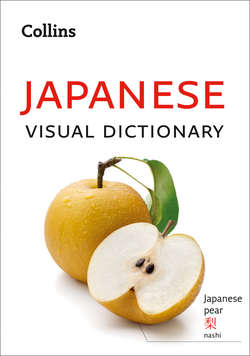Читать книгу Collins Japanese Visual Dictionary - Collins Dictionaries - Страница 5
INTRODUCTION
ОглавлениеWhether you’re on holiday or staying in Japan for a slightly longer period of time, your Collins Visual Dictionary is designed to help you find exactly what you need, when you need it. With over a thousand clear and helpful images, you can quickly locate the vocabulary you are looking for.
The Visual Dictionary includes:
10 chapters arranged thematically, so that you can easily find what you need to suit the situation
images – illustrating essential items
YOU MIGHT SAY… – common phrases that you might want to use
YOU MIGHT HEAR… – common phrases that you might come across
VOCABULARY – common words that you might need
YOU SHOULD KNOW… – tips about local customs or etiquette
USING YOUR COLLINS VISUAL DICTIONARY
The points below explain a few basic concepts of Japanese pronunciation and grammar and will help ensure that your Collins Visual Dictionary gives you as much help as possible when using Japanese:
1) There are several systems for writing Japanese in Roman characters, but the most understandable for English speakers is called the Hepburn system, which has been adapted slightly for use in this dictionary. Long vowels (pronounced with twice the length of normal vowels) have been written with a bar over the top, except for the double i:
ā ii ē ō ū
bus stop バス停 basu-tē
street 通り tōri
2) Japanese grammar is simple in many ways compared to European languages: there is no gender and there are no definite or indefinite articles; there is no difference between singular and plural; and verbs only have past and non-past (present or future) forms and do not change according to who is performing an action.
3) There are different levels of politeness in Japanese, but polite forms suitable for general use have been used in the phrases in this book.
Verbs are shown in the “plain” form. This is the form used among family members and close friends, and to form more complex structures, so you may hear people using it. However, it is safest to stick to using the polite form to avoid appearing over-familiar or rude. In the polite form, Japanese verbs end in “-masu”. Negative forms and past tenses are made by changing the verb ending.
4) Japanese uses small words called particles to show how different parts of the sentence relate to each other. Some are similar to English prepositions, but in Japanese they come immediately after the nouns they refer to. These particles have the following functions:
| wa | topic marker |
| ga | subject marker |
| o | direct object marker |
| ni | indirect object marker, goal and location marker |
| to | connects nouns, ‘and’ or ‘with’ |
| de | indicates by which means an action is carried out or where an action takes place |
| no | indicates that the second noun is described in some way by the first, e.g. possession |
| mo | “also/as well” |
| kara | “from/since” |
| made | “until/as far as” |
Other particles occur at the end of sentences to change the meaning from a straightforward statement. The most common ones are:
| ka | question marker |
| ne | asks for agreement or confirmation |
| yo | adds emphasis |
Finally, some particles are used to link clauses to make more complex sentences. Two of the most useful are kara “because/so” (which always comes after the reason or cause) and ga “but/although”.
5) Japanese word order is subject – object – verb, with the verb at the end of the sentence. The basic Japanese sentence has a topic and a comment section. The topic, indicated by the topic marker wa, usually comes at the beginning of the sentence, but if it is understood among the speakers or from the context, it is often omitted. Personal pronouns are avoided; instead, the person’s name is normally used, even for “you”. The most neutral order for additional phrases in longer sentences is time – manner – place.
FREE AUDIO
We have created a free audio resource to help you learn and practise the Japanese words for all of the images shown in this dictionary. The Japanese words in each chapter are spoken by native speakers, giving you the opportunity to listen to each word twice and repeat it yourself. Download the audio from the website below to learn all of the vocabulary you need for communicating in Japanese.
www.collinsdictionary.com/resources
